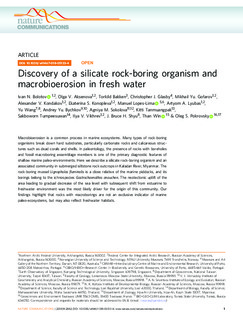| dc.contributor.author | Bolotov, Ivan N. | |
| dc.contributor.author | Aksenova, Olga V. | |
| dc.contributor.author | Bakken, Torkild | |
| dc.contributor.author | Glasby, Christopher J. | |
| dc.contributor.author | Gofarov, Mikhail Yu. | |
| dc.contributor.author | Kondakov, Alexander V. | |
| dc.contributor.author | Konopleva, Ekaterina S. | |
| dc.contributor.author | Lopes-Lima, Manuel | |
| dc.contributor.author | Lyubas, Artyom A. | |
| dc.contributor.author | Wang, Yu | |
| dc.contributor.author | Bychkov, Andrey Yu. | |
| dc.contributor.author | Sokolova, Agniya M. | |
| dc.contributor.author | Tanmuangpak, Kitti | |
| dc.contributor.author | Tumpeesuwan, Sakboworn | |
| dc.contributor.author | Vikhrev, Ilya V. | |
| dc.contributor.author | Shyu, J. Bruce H. | |
| dc.contributor.author | Win, Than | |
| dc.contributor.author | Pokrovsky, Oleg S. | |
| dc.date.accessioned | 2018-11-23T12:16:43Z | |
| dc.date.available | 2018-11-23T12:16:43Z | |
| dc.date.created | 2018-11-06T21:34:38Z | |
| dc.date.issued | 2018 | |
| dc.identifier.citation | Nature Communications. 2018, 9 (1), . | nb_NO |
| dc.identifier.issn | 2041-1723 | |
| dc.identifier.uri | http://hdl.handle.net/11250/2574579 | |
| dc.description.abstract | Macrobioerosion is a common process in marine ecosystems. Many types of rock-boring organisms break down hard substrates, particularly carbonate rocks and calcareous structures such as dead corals and shells. In paleontology, the presence of rocks with boreholes and fossil macroboring assemblage members is one of the primary diagnostic features of shallow marine paleo-environments. Here we describe a silicate rock-boring organism and an associated community in submerged siltstone rock outcrops in Kaladan River, Myanmar. The rock-boring mussel Lignopholas fluminalis is a close relative of the marine piddocks, and its borings belong to the ichnospecies Gastrochaenolites anauchen. The neotectonic uplift of the area leading to gradual decrease of the sea level with subsequent shift from estuarine to freshwater environment was the most likely driver for the origin of this community. Our findings highlight that rocks with macroborings are not an exclusive indicator of marine paleo-ecosystems, but may also reflect freshwater habitats. | nb_NO |
| dc.language.iso | eng | nb_NO |
| dc.publisher | Nature Research | nb_NO |
| dc.relation.uri | https://www.nature.com/articles/s41467-018-05133-4 | |
| dc.rights | Navngivelse 4.0 Internasjonal | * |
| dc.rights.uri | http://creativecommons.org/licenses/by/4.0/deed.no | * |
| dc.title | Discovery of a silicate rock-boring organism and macrobioerosion in fresh water | nb_NO |
| dc.title.alternative | Discovery of a silicate rock-boring organism and macrobioerosion in fresh water | nb_NO |
| dc.type | Journal article | nb_NO |
| dc.type | Peer reviewed | nb_NO |
| dc.description.version | publishedVersion | nb_NO |
| dc.source.pagenumber | 9 | nb_NO |
| dc.source.volume | 9 | nb_NO |
| dc.source.journal | Nature Communications | nb_NO |
| dc.source.issue | 1 | nb_NO |
| dc.identifier.doi | https://doi.org/10.1038/s41467-018-05133-4 | |
| dc.identifier.cristin | 1627748 | |
| dc.description.localcode | © The Author(s) 2018. This article is licensed under a Creative Commons Attribution 4.0 International License. | nb_NO |
| cristin.unitcode | 194,31,10,0 | |
| cristin.unitname | Institutt for naturhistorie | |
| cristin.ispublished | true | |
| cristin.fulltext | original | |
| cristin.qualitycode | 2 | |

